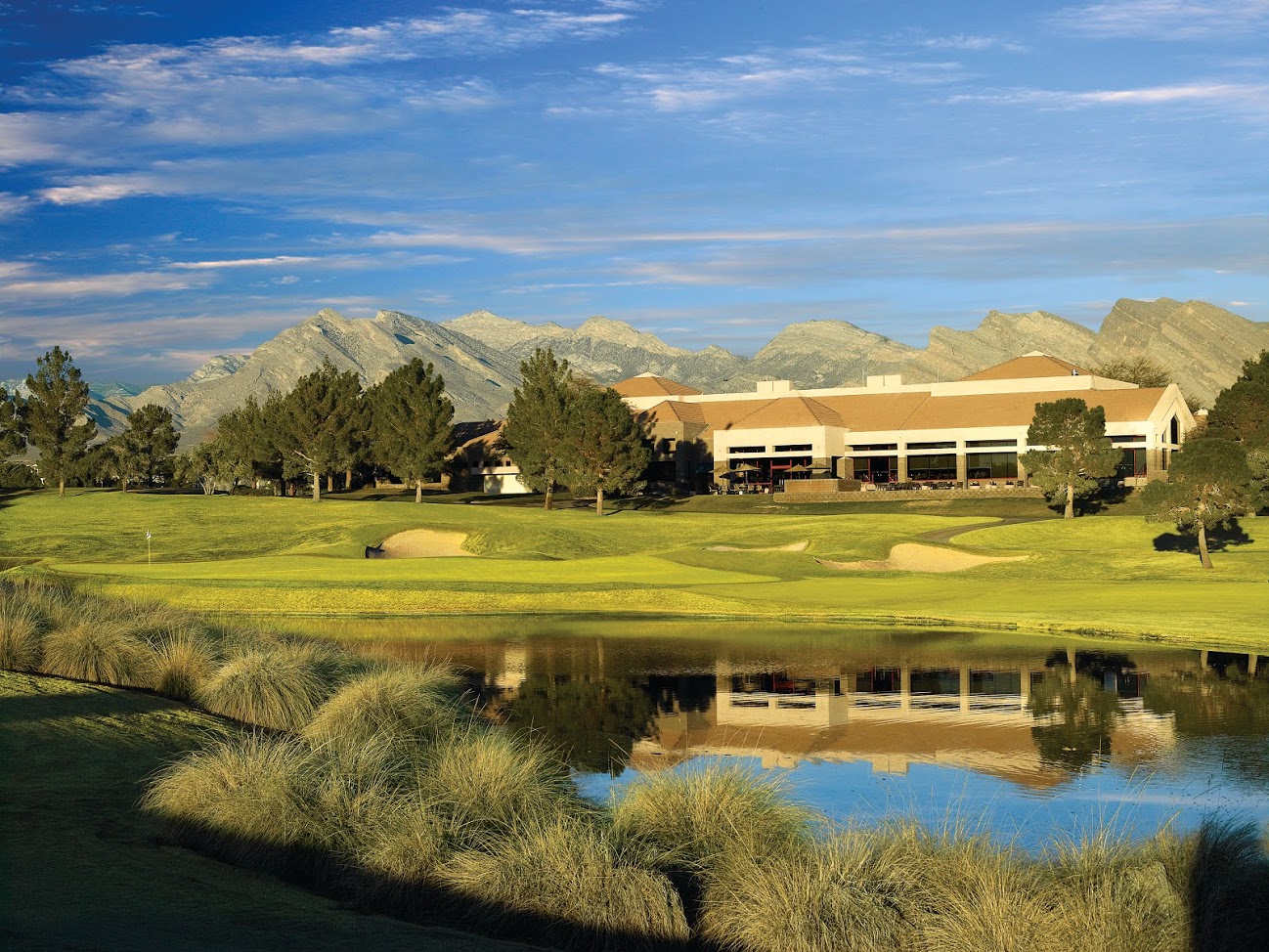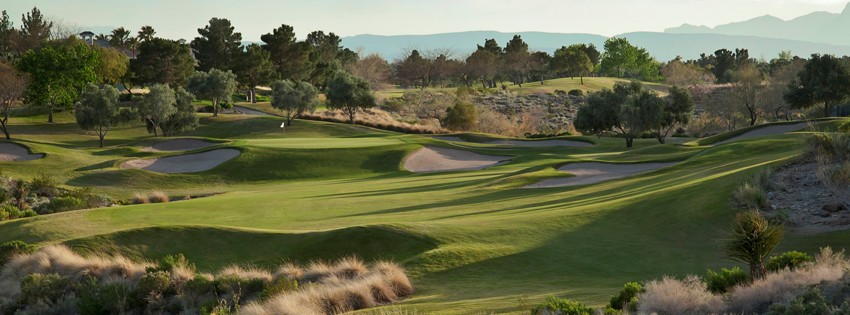
Those people who say that everything in Las Vegas is gaudy and “over the top” by design need to spend a few hours on the golf course at TPC Summerlin, a wonderful, solid and a bit understated facility (at least by Sin City standards) that will host the PGA Tour’s Shriners Children’s Open for the 30th consecutive year from Oct. 6-9.
That’s not to say that TPC Summerlin is not large in scale and plush to the nth degree – because it is. It’s just not all flash and dash like so many other things in Vegas, and that’s a good thing.
It’s also one of two courses here that are members of the expansive TPC Network of properties, a roster that was established with hosting PGA Tour events in mind, and feature services and amenities that meet the ultimate standards of professional golf.

TPC Summerlin
TPC Summerlin: The history
TPC Summerlin opened in 1991 and was designed by Bobby Weed and Fuzzy Zoeller, who routed the course through what was once rugged desert terrain.
TPC Summerlin is the centerpiece of the expansive Summerlin community about 15 miles northwest of the Las Vegas Strip and was the first course, and now one of 10 (along with TPC Las Vegas), in the 22,500-acre master-planned property.
Summerlin was named after Jean Amelia Summerlin, the grandmother of billionaire land-developer, movie studio owner, and aviator Howard Hughes. The Howard Hughes Corporation maintains ownership of the master-planned community, and the winner of the Shriners Children’s Open will take home $1.4 million of the $8 million total purse as well as the Howard Hughes Cup.
The course meanders over and through arroyos and canyons, with flawless and lightning-quick Bent grass greens, striking flora, numerous water features, and an abundance of honey mesquite and pine trees that provide a dramatic contrast to the native landscape that surrounds it.
That combination and disparity between what makes up the community and the desert create one of the most visually stunning tests of golf in Nevada. TPC Summerlin’s member layout stretches to 7,255 yards and plays to a par of 72. During the Shriners it gets bumped down to a par of 71 by turning the third hole from a par 5 to a par 4.
TPC Summerlin has some drastic elevation changes and features a number of exceptionally tough putting surfaces with wild undulations.
Playing a course where a PGA Tour event is held is unique because that you can see the course during the broadcast and relive your round. TPC Summerlin was designed, as are most of the courses in the TPC Network, with a furious finish as the highlight of the routing in an effort to create drama on Sunday afternoons or, in the everyday player’s case, at the end of the round.

TPC Summerlin: The course
The course’ front nine takes the player through some treacherous terrain that demands players stay in the short grass and out of the native areas.
The 469-yard par-4 second hole has the desert as its border on the right and a pesky bunker on the left to grab the over-cautious tee shot. The approach is to an unusually small green, at least for this course.
The aforementioned third plays at 496 yards for the pros and has trouble on both sides of the landing area. Where the normal player will have to decide about positioning on the layup, the PGA Tour players will take aim at a putting surface that’s more wide than deep and has bunkers both at the front and the rear.
The beast on the front nine is the 239-yard par-3 eighth. On top of its length there are a trio of bunkers resting on the low side of the elevated putting surface and another bunker behind it. Over the years the PGA Tour has visited TPC Summerlin, this hole has consistently played the highest average score above par on the course.
After the turn, the 12th – at 442 yards – has water that is reachable from the tee so the player can lay up short of it to set up a longer approach or can thread the needle between the water and bunkers to leave a little less stress on the approach. The green is hard on the water and moves plenty, with some segments toward the pond.
TPC Summerlin has four absolutely outstanding closing holes that cover a wide variety of playability.
The 15th is a drivable 341-yard par-4. A waste area and bunker sit in the middle of the fairway and force players to choose between the high ground and the low road. The severely elevated green is protected by a quintet of bunkers immediately around the putting surface, whose dramatic undulations makes getting up and down a challenge even for the world’s best players.
No. 16 is a great risk/reward par-5, with a large pond that needs to be carried on the approach if the player decides to go for it in two shots. Golfers who take an extra club on the 560-yard hole may find themselves in one of two bunkers behind the green, which is very shallow and wide, and be left with the dreaded sand shot back towards the water.
The 196-yard par-3 17th was made famous by one of the most clutch shots in PGA Tour history. It’s where Jonathan Byrd poured in a hole-in-one to win a three-man playoff on the fourth sudden-death hole in 2010. With water on the left and bunkers on the right, the 17th represents one of the most exciting shots of the round, with the experience magnified by the elevated tee box and the views offered from that lofted perch.
TPC Summerlin wraps up with a bang. The 444-yard par-4 has a hazardous canyon to the left, mountains in the distance and a lake that guards the long front-to-back green. It is a great conclusion to a wonderful championship course.
Lest we forget, TPC Summerlin was also the site of Tiger Woods’ first-ever PGA Tour title in 1996.
Always well maintained, TPC Summerlin is a fun and challenging course. With picturesque mountain ranges to the west and the famous Vegas skyline to the east there are plenty of visual stimulants throughout.

Bali Hai
Other great options in Vegas
Unlike some other places where the PGA Tour plays its events, there are likely as many great public access/daily fee/resort courses in Las Vegas as there are private facilities – and some that are even better. Here are five to consider when you are in Sin City:
Bali Hai Golf Club
Bali Hai Golf Club is the course that is the easiest to get to from the Strip and one of the most challenging in the area. It’s certainly an oasis in the desert, designed by Lee Schmidt and Brian Curley and replete with a seven-acre lake and more than 4,000 trees and over 100,000 Balinese tropical plants that help define its fairways. There’s certainly no other course – perhaps outside the super-exclusive Wynn Golf Club – that epitomizes the glitz and glamor of a visit to Las Vegas.
Las Vegas Paiute Resort
About another 15 miles past TPC Summerlin is the peerless Las Vegas Paiute Golf Resort, home of three demanding but fun Pete Dye-designed courses in the absolute middle of the desert. The three courses – Snow Mountain, Sun Mountain and Wolf, listed in the order they were built – were designed to be playable yet challenging. They all bear Dye’s architecture characteristics, with mounding, railroad-tie bunkers, plenty of water in play and a distinct fairness in their routing despite their definite challenge and varying tests.
TPC Las Vegas
The sister course to TPC Summerlin in the huge master-planned community, TPC Las Vegas differs with a more rugged look that creates contrast with the natural wash areas and transplanted desert plants for a course that looks anything but manufactured. Designed by Weed along with Raymond Floyd, the course has only 110 acres of irrigated land. That architectural tack also created many forced-carry shots, and it’s up to the player to figure out how much of a risk to take. It helps that the landing areas are generous (50 yards wide on some holes) and that most shots on the edges seem to find their way back into play. When
the course first opened the putting surfaces were considered extreme and unfair, but after growth and maturity they are among the highlights.
Cascata
On the other side of town on the way to Boulder Dam is the sublime Cascata Golf Club, a Rees Jones-design that’s highly acclaimed and often talked about in hushed tones, like a secret to be cherished. The course opened in 2000 and is considered among the best and most lavish in the country, if not the world. It was named from the Italian word for “waterfall,” appropriate since a 418-foot, man-made, switch-it-off-and-on cascade plunges down the side of a mountain to form a thundering river that flows through an amazing 37,000-square-foot clubhouse. The course involves desert, the 3,600-foot Red Mountain – over which you play and return (all the holes go north to south, or vice versa), verdant fairways, sparkling lakes, and crystal streams. Cascata recognizes customers of Caesars Entertainment’s loyalty program, with discounts off green fees based on tier status.

Paiute

